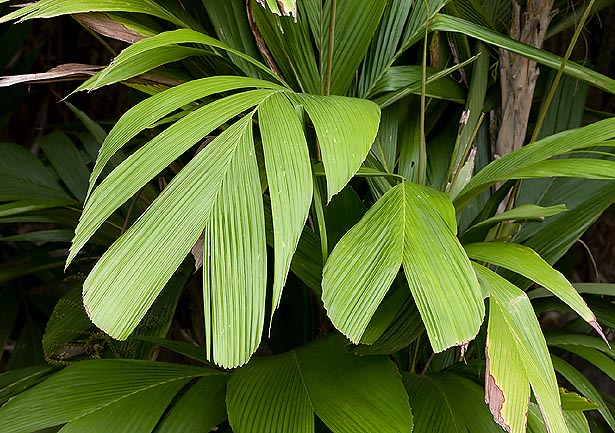Family : Arecaceae

Text © Pietro Puccio

English translation by Mario Beltramini

The Iguanura wallichiana is a 3 m cespitose tropical palm with vey decorative leaves © Giuseppe Mazza
The name of the genus comes from the combination of the name of the reptilian “iguana” with the Greek word “uros” = tail, with reference to the resemblance of the inflorescences of some species belonging to the genus with the tail of the above cited reptilian; the species is honoured to the Danish botanist Nathaniel Wallich (1786-1854).
Common names: guana palm (English); tronok (Malaysian); mareng, mrang (Thai).
The Iguanura wallichiana (Mart.) Becc. (1886) is a monoecious plant, caespitose, rather variable, with stems tall up to 3 m with a diameter of about 3 cm and pinnate leaves, up to 1,5 m long, on a petiole long about 15 cm. The lamina is irregularly divided, the folioles, 3-12 per side, are up to 50 cm long and 3-25 cm broad, rigid, with several parallel nervations and indented edge; the foliar base, about 25 cm tall swathes only partially the stem.
The colour of the leaves at the opening is brown red and then turns to the intense green. The inflorescences come out between the leaves, are about 70 cm long, slanting upward, and formed by a central axis (rachis), from which depart 6-12 lateral floriferous branches (rachillae), carrying white flowers placed in the typical triad (one female flower between two male ones). The inflorescence has the phenomenon of the proterandry, the male flowers ripe before the female ones, thus favouring the crossed fecundation. The fruits are ovoid, 3 cm long and with a diameter of 2 cm, red when ripe and containing one seed only. It reproduces by seed and by division.
It is the most common species, in the wild, of the genus Iguanura, but it is such also in cultivation, due to the elegance and the particularity of the foliage, solely in the humid tropical climate zones, in shaded position, on preferably acidic soils, and kept constantly humid. Its cultivation may be tried in the subtropical climate zones where the temperatures below the +10 °C are an exceptional case of short duration. It is particularly appreciated and sought for as pot plant for greenhouses decoration, winter gardens and even little luminous inner spaces, where it may even survive for long time, utilizing moulds slightly acidic, draining, kept humid and with temperatures over the 16 °C.
Synonyms: Areca wallichiana Mart. (1838).
→ For general notions about ARECACEAE please click here.
